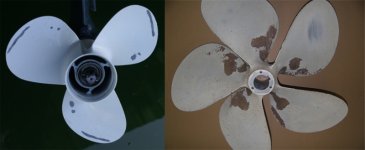I have two new (less than 50 hours) props on my Yamaha F50's. The port side is wearing badly, but the starboard looks brand new.
There is no apparent difference in performance between the two - no vibration or slippage that I can detect. Cursory examination reveals no obvious defect in the port side prop, but I'm assuming there must be some. Previous props had 100's of hours and showed no wear like this on either engine. The Permatrims were installed well before the new props. I haven't run aground (recently!) or hit anything I know of since the new props were installed.
I'm about to experiment by swapping props between the two engines, but I'd hate to mess up the good one if the problem is not the prop itself. Any thoughts?

There is no apparent difference in performance between the two - no vibration or slippage that I can detect. Cursory examination reveals no obvious defect in the port side prop, but I'm assuming there must be some. Previous props had 100's of hours and showed no wear like this on either engine. The Permatrims were installed well before the new props. I haven't run aground (recently!) or hit anything I know of since the new props were installed.
I'm about to experiment by swapping props between the two engines, but I'd hate to mess up the good one if the problem is not the prop itself. Any thoughts?


![Normal_Cavitaion_Burn[1].jpg](http://www.musselbuster.com/images/Normal_Cavitaion_Burn[1].jpg)

